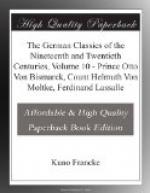The Emperor spoke to some of them. They answered their Batuschka (little father) without embarrassment. In Russia the family is the microcosm of the State. All power rests with the father. All theories of representative government in Russia are pure nonsense. “How can human statutes circumscribe the divine right of a father?” asks the Russian. So that the unlimited power in the hands of the Emperor is necessary and beneficial in a land where nothing is done that is not ordered from above.
Whoever should gaze, as I have done, on a warm, sunny day, upon the city of Moscow for the first time from the height of the Kremlin would certainly not think that he was in the same latitude in which the reindeer graze in Siberia, and the dogs drag the sleighs over the ice in Kamtchatka. Moscow reminds one of the South, but of something strange never seen before. One seems to be transported to Ispahan, Bagdad, or some other place—to the scene of the story of the Sultaness Scheherezade.
Although Moscow does not count more than three hundred thousand inhabitants, it covers two square miles with its houses, gardens, churches, and monasteries. In this flat region one can hardly see beyond the extreme suburbs, and houses and trees extend to the horizon.
No city in the world, with the exception of Rome, has so many churches as the holy Stolitza of Russia. It is affirmed that Moscow boasts of forty times forty churches. Each one has at least five, and several even sixteen, cupolas that are brilliantly painted, and covered with colored glazed bricks, or richly silvered and gilded, glittering in the blue atmosphere like the sun when it is half above the horizon. Even the graceful towers, rising sometimes to considerable heights from the immense mass of houses and gardens, are similarly ornamented, and neither do the larger ones among the palaces lack the addition of a cupola.
The dwelling houses are almost always in gardens, and are distinctly outlined against the dark background of trees by their white walls and flat iron roofs painted light green or red. The oldest part alone, close to the Kremlin—the Kitai-Gorod, or the Chinese quarter—forms a city according to our notions, where the houses touch each other, and are carefully enclosed by a beautiful turreted wall, here, of course, painted white. All the rest seems to be a large collection of country houses, between which the Moskwa winds its way.
The Kremlin contains (besides the palaces of the Czars and the Patriarchs) the Arsenal and the treasures of the church. Here are concentrated the highest civil and religious powers. The cloisters, mostly at the extremities of the city, are fortresses in themselves.
It was in the Kitai-Gorod that the commercial guild established itself, needing for its wares, imported from China, Bucharia, Byzantium, and Novgorod, the protection of walls. The rest, and by far the larger part of Moscow, was built by the nobility for themselves; and long after the first Emperor had raised a new capital upon the enemy’s ground it was looked upon with contempt by the grandees of the Empire, still faithfully clinging to the customs of their fathers.




